How to remove Makop ransomware and prevent further file encryption?
RansomwareAlso Known As: Makop virus
Get free scan and check if your device is infected.
Remove it nowTo use full-featured product, you have to purchase a license for Combo Cleaner. Seven days free trial available. Combo Cleaner is owned and operated by RCS LT, the parent company of PCRisk.com.
What kind of malware is Makop?
Makop is a type of malware categorized as ransomware. It operates by encrypting data of infected systems and demanding payment for decryption tools/software. During the encryption process, all affected files are renamed according to this pattern: original filename, unique ID, cyber criminals' email address and the ".makop extension.
For example, a file named "1.jpg" would appear as something like "1.jpg.[EF7BE7BC].[makop@airmail.cc].makop", and so on. After this process is finished, a text file named "readme-warning.txt" is created on the desktop.
Screenshot of files encrypted by Makop ransomware:
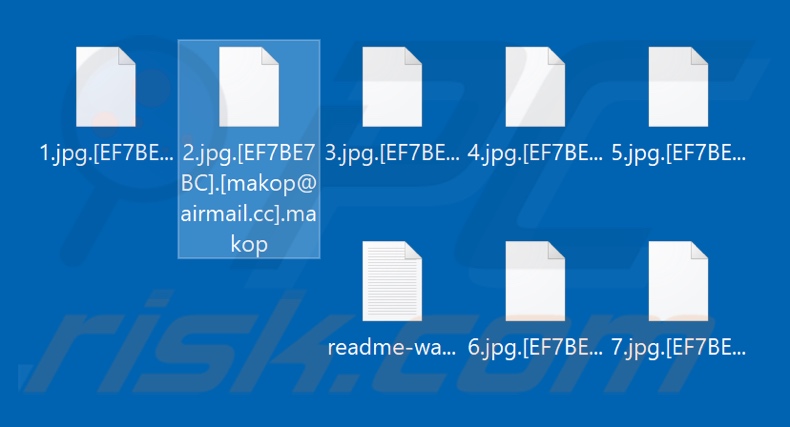
Makop ransomware in detail
The text file contains the ransom message, which clarifies that the victim's data has not been damaged, but was encrypted. According to the message, the only way to recover the compromised files is to purchase decryption tools from the developers of Makop ransomware.
To receive further instruction, the message instructs people to establish contact with the criminals via email. Prior to paying, victims can test decryption by sending up to two small files (no larger than 1 MB each). These test files cannot contain valuable information such as databases.
Formats such as .jpg, .xls and .doc are given as examples of which files can be used for this purpose. The size of the ransom is not stated, however, the Bitcoin cryptocurrency is stipulated for payments. Following payment, users are promised that they will receive decryption tools/software and instructions about how to use them.
The message ends with warnings that modifying the encrypted files in any way, attempting to decrypt them with third party software, or running anti-virus programs can result in permanent data loss. It therefore recommends making copies of the files before trying any of the aforementioned actions.
More information about ransomware
In most cases of ransomware infections, decryption is impossible without the involvement of the malware developers, unless the malicious program is still in development and/or has certain bugs/flaws. Regardless, do not communicate with or meet the demands of cyber criminals.
These individuals cannot be trusted. Despite paying, victims do not receive the necessary tools/software to decrypt their data. Therefore, their files remain encrypted and useless, and they experience significant financial loss. To prevent Makop from further encryption, it must be removed from the operating system.
Unfortunately, removal will not restore already affected data. The only solution is to recover files from a backup, if one was made before the infection and was stored in a separate location.
Ransomware in general
Ransomware is designed to encrypt files and demand ransom payments for decryption. TRSomware Is Back, Ragnarok, PRT and Devos are some examples of these malicious programs, however, there are several key differences: the cryptographic algorithm they use (symmetric or asymmetric) and ransom size.
The ransom sums tend to range between three and four digits (in USD). Cyber criminals prefer digital currencies (mainly, cryptocurrencies), since these transactions are difficult/impossible to trace. To protect your data from these infections, keep backups on remote servers and/or unplugged storage devices (ideally, in multiple locations).
How did ransomware infect my computer?
Ransomware and other malware is primarily spread via spam campaigns, Trojans, software "cracking" (activation) tools, fake updaters and untrusted download channels. "Spam campaign" is a term used to define the act of sending deceptive/scam emails on a large scale. This mail is usually disguised as "official", "priority", "important" or similar.
These messages have infectious files attached to, or linked inside. The dangerous files can be in various formats (e.g. executable and archive files, PDF and Microsoft Office documents, JavaScript, etc.). When they are opened, the infection is started (i.e., they begin download/installation of malware).
Trojans are malicious programs capable of causing chain infections. Rather than activating licensed products, illegal activation ("cracking") tools can download/install malicious software. Rogue updaters infect systems by exploiting flaws present in outdated programs and/or simply by installing malware rather than the promised updates.
Malicious content is often downloaded from untrusted download sources such as unofficial and free file-hosting websites, Peer-to-Peer sharing networks (BitTorrent, Gnutella, eMule, etc.) and other third party downloaders.
| Name | Makop virus |
| Threat Type | Ransomware, Crypto Virus, Files locker. |
| Encrypted Files Extension | .makop (files are also appended with a unique ID and developer's email address). |
| Ransom Demand Message | readme-warning.txt |
| Cyber Criminal Contact | datalost@foxmail.com, crypt@qbmail.biz, akzhq00705@protonmail.com, payforkey@cock.li, omegatechit@tuta.io, omegatechit@protonmail.com, synchronized@msgsafe.io, coleman.dec@tutanota.com, lauracc@msgsafe.io, synchronized@gmx.com, mak_supp@aol.com, compromised@airmail.cc, mak_supp@hotmail.com, makopsupp@tutanota.com, votrefile@tuta.io, davidrecovery@protonmail.com, getdataback@qbmail.biz, luntik2316@protonmail.com, akzhq615@protonmail.com, akzhq530@protonmail.com, mrdjohni@tutanota.com, akzhq412@aol.com, savedata2@protonmail.com, ruthlessencry@qq.com, irisaneby@aol.com, makop@tuta.io, tomasrich2020@aol.com, genfiles@protonmail.com, backup_499@protonmail.com, killyouass@protonmail.com, buydecryptor@aol.com, restoring.data@protonmail.com, farik1@protonmail.com, antiransomware@aol.com, admcphel@protonmail.ch, akzhq12@cock.li, data.compromised@protonmail.com, giantt1@protonmail.com, viginare@aol.com, verilerimialmakistiyorum@inbox.ru, moncler@cock.li, ww6666@protonmail.com, xaodecrypt@protonmail.com, cock89558@cock.li, prndssdnrp@mail.fr, MikeyMaus77@protomail.com, modeturbo@aol.com, buydecryptor@cock.li, checkfilelock@protonmail.ch, akzhq710@protonmail.com, payfordecoder@hotmail.com, paymantsystem@cock.li, akzhq725@tutanota.com, myfiles@msgsafe.io, akzhq808@tutanota.com, ranbarron88@qq.com, encryptboys@tutanota.com, greenreed007@qq.com, crypt@zimbabwe.su, helpdesk_makp@protonmail.ch, makop@airmail.cc, joshua_antony@aol.com, akzhq830@tutanota.com, makopfiles@aol.com, myfilesdecrypt@cock.li, steaknshake@gmx.us, makop@keemail.me, makop.support@secmail.pro, cloudfiles@msgsafe.io, cloudfiles@airmail.cc, akzhq915@tutanota.com, akzhq915@airmail.cc, akzhq915@protonmail.ch, dino@rape.lol, dino_rans@protonmail.ch, akzhq1010@tutanota.com, akzhq1010@cock.li, poyasecurity@protonmail.com, poyasecur@gmail.com, manage.file@messagesafe.io, morrith_smith@tutanota.com, moloch_helpdesk@tutanota.com, moloch_helpdesk@protonmail.ch, lock59@airmail.cc, backup1950@msgsafe.io, loyaldecrzpt@aol.com, loyaldecrypt@privatemail.com, btcsupport@bingzone.net, btcsupport@cock.li, grhoster-123@tutanota.com, dweezells@airmail.cc, mozgpitona@outlook.com, yamer2@protonmail.com, saveisos@aol.com, kobihornegushersamuels@protonmail.com, phillipdyercostarican@tutanota.com, makop@outlookpro.net, makop@rape.lol, sirketverileri@protonmail.com, xiaojunye@tutanota.com, 1527436515@qq.com, norahghnq@gmx.com, decryption@techmail.info, hopeandhonest@smime.ninja, playerplaya@protonmail.com, apollo55supp@protonmail.com, filerecov3ry@keemail.me, evilminded@privatemail.com, yourfriendz@keemail.me, honestandhope@qq.com, alexpetrov11094@gmail.com, darknet@techmail.info, ustedesfil@tuta.io, daviderichardo@tutanota.com, daviderichardo@messagesafe.io, goldenmark@yahooweb.co, apollo55@lenta.ru, undergrounda@lenta.ru, mariany@msgden.net, mymakopfile@tutanota.com, ustedesfil@safeswiss.com, yourfriendz@secmail.pro, mondezir@mailfence.com, goodhack@privatemail.com, ideapad@privatemail.com, esupport@privatemail.com, willettamoffat@yahoo.com, yourdataonline@aliyun.com, hello2021ola@protonmail.com, makopransom@outlook.com, decryption@msgden.com, paybackformistake@qq.com, jackydonovan@protonmail.com, shikotan@happygoluckyclub.com, yourfriendz@techmail.info, companyblast@msgsafe.io, colemandec@tutanota.com, @saveisos (Telegram) |
| Detection Names | BitDefender (Gen:Heur.Kelios.1), Fortinet (W32/Cryptor.CZN!tr.ransom), ESET-NOD32 (A Variant Of Win32/Filecoder.Phobos.E), Emsisoft (Gen:Heur.Kelios.1 (B)), Full List Of Detections (VirusTotal) |
| Symptoms | Cannot open files stored on your computer, previously functional files now have a different extension (for example, my.docx.locked). A ransom demand message is displayed on your desktop. Cyber criminals demand payment of a ransom (usually in bitcoins) to unlock your files. |
| Distribution methods | Infected email attachments (macros), torrent websites, malicious ads. |
| Damage | All files are encrypted and cannot be opened without paying a ransom. Additional password-stealing Trojans and malware infections can be installed together with a ransomware infection. |
| Malware Removal (Windows) |
To eliminate possible malware infections, scan your computer with legitimate antivirus software. Our security researchers recommend using Combo Cleaner. Download Combo CleanerTo use full-featured product, you have to purchase a license for Combo Cleaner. 7 days free trial available. Combo Cleaner is owned and operated by RCS LT, the parent company of PCRisk.com. |
How to protect yourself from ransomware infections
Do not open unknown, suspicious or irrelevant emails. Any attachments or links present in dubious messages must never be opened, as doing so can lead to an infection. All downloads should be performed from official and verified download channels. Use tools/functions provided by genuine developers to activate and update programs.
Illegal activation tools ("cracks") and third party updaters carry a high risk of malware installation, and therefore should be avoided. Have reputable anti-virus/anti-spyware software installed. This must be kept up to date and used to perform regular system scans and for the removal of detected/potential threats.
If your computer is already infected with Makop, we recommend running a scan with Combo Cleaner Antivirus for Windows to automatically eliminate this ransomware.
Screenshot of a message encouraging users to pay a ransom to decrypt their compromised data:
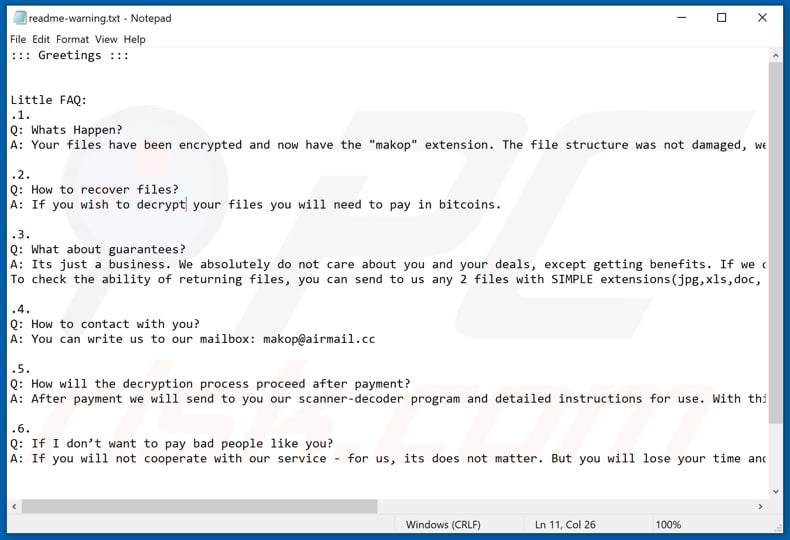
Text presented in Makop ransomware text file ("readme-warning.txt"):
::: Greetings :::
Little FAQ:
.1.
Q: Whats Happen?
A: Your files have been encrypted and now have the "makop" extension. The file structure was not damaged, we did everything possible so that this could not happen..2.
Q: How to recover files?
A: If you wish to decrypt your files you will need to pay in bitcoins..3.
Q: What about guarantees?
A: Its just a business. We absolutely do not care about you and your deals, except getting benefits. If we do not do our work and liabilities - nobody will cooperate with us. Its not in our interests.
To check the ability of returning files, you can send to us any 2 files with SIMPLE extensions(jpg,xls,doc, etc... not databases!) and low sizes(max 1 mb), we will decrypt them and send back to you. That is our guarantee..4.
Q: How to contact with you?
A: You can write us to our mailbox: makop@airmail.cc.5.
Q: How will the decryption process proceed after payment?
A: After payment we will send to you our scanner-decoder program and detailed instructions for use. With this program you will be able to decrypt all your encrypted files..6.
Q: If I donít want to pay bad people like you?
A: If you will not cooperate with our service - for us, its does not matter. But you will lose your time and data, cause only we have the private key. In practice - time is much more valuable than money.:::BEWARE:::
DON'T try to change encrypted files by yourself!
If you will try to use any third party software for restoring your data or antivirus solutions - please make a backup for all encrypted files!
Any changes in encrypted files may entail damage of the private key and, as result, the loss all data.
Update 24 March 2020 - Cyber criminals have recently released yet another variant of Makop ransomware, which drops a different ransom message and appends filenames only with the victim's unique ID and the ".makop" extension (e.g., "1.jpg" is renamed to "1.jpg.[E38D7F03-W].makop" and so on).
Screenshot of the updated Makop ransomware text file ("readme-warning.txt"):
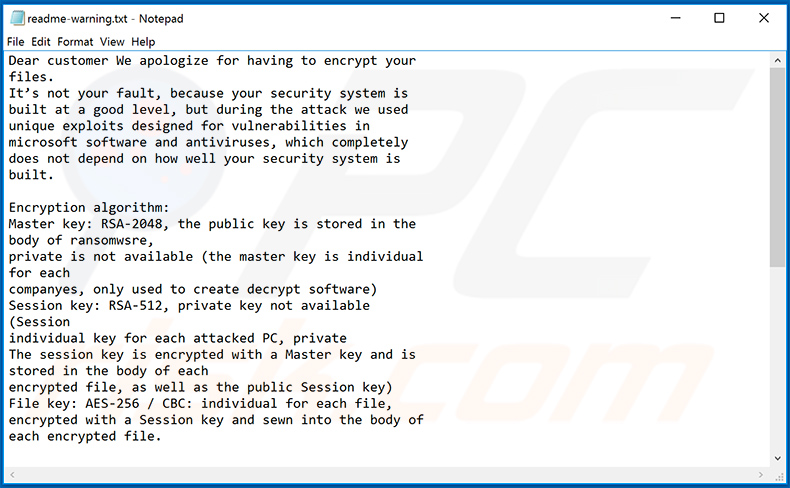
Text presented within this file:
Dear customer We apologize for having to encrypt your
files.
It’s not your fault, because your security system is
built at a good level, but during the attack we used
unique exploits designed for vulnerabilities in
microsoft software and antiviruses, which completely
does not depend on how well your security system is
built.Encryption algorithm:
Master key: RSA-2048, the public key is stored in the
body of ransomwsre,
private is not available (the master key is individual
for each
companyes, only used to create decrypt software)
Session key: RSA-512, private key not available
(Session
individual key for each attacked PC, private
The session key is encrypted with a Master key and is
stored in the body of each
encrypted file, as well as the public Session key)
File key: AES-256 / CBC: individual for each file,
encrypted with a Session key and sewn into the body of
each encrypted file.We strongly recommend that you do not use third-party
software to decrypt your files, as this can lead to
the final loss of files due to corrupted headers. But
if you still want to try to decrypt your files
yourself, then make sure that you back up all
encrypted files.
You can familiarize yourself with our product on the
following reputable site:
hxxps://www.bleepingcomputer.com/forums/t/712395/oled-makop-ransonware-makop-support-topic/In no case do we extort money from you, we only offer
you our services for decrypting your files + you can
get a bonus in the form of a free audit of your
security system in order to protect yourself from such
attacks and malicious software in the future.You can contact us by email: established01@protonmail.com
In the subject line, indicate your personal ID number,
which is indicated in the name of your files.
If you do not receive a response after 6 hours, then
resend the message to our backup email:
fargodrops@cock.li
Screenshot of files encrypted by this Makop ransomware variant:
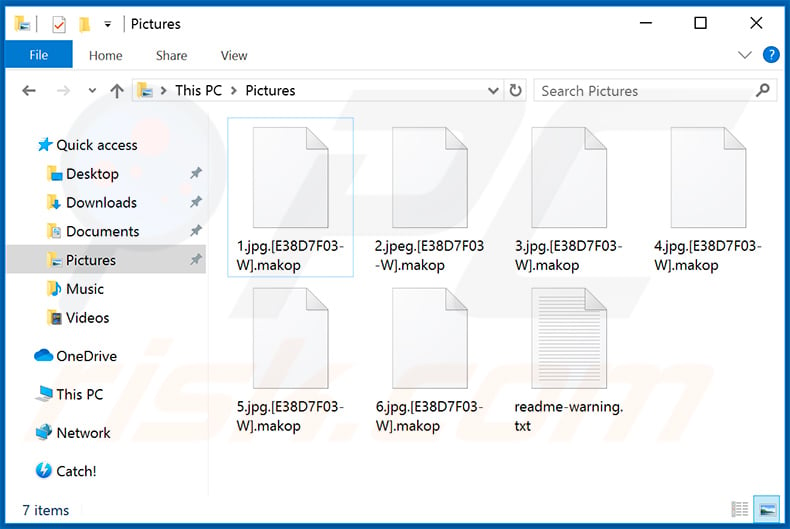
Appearance of another variant of the Makop ransomware ransom message, which targets Turkish-speaking users:
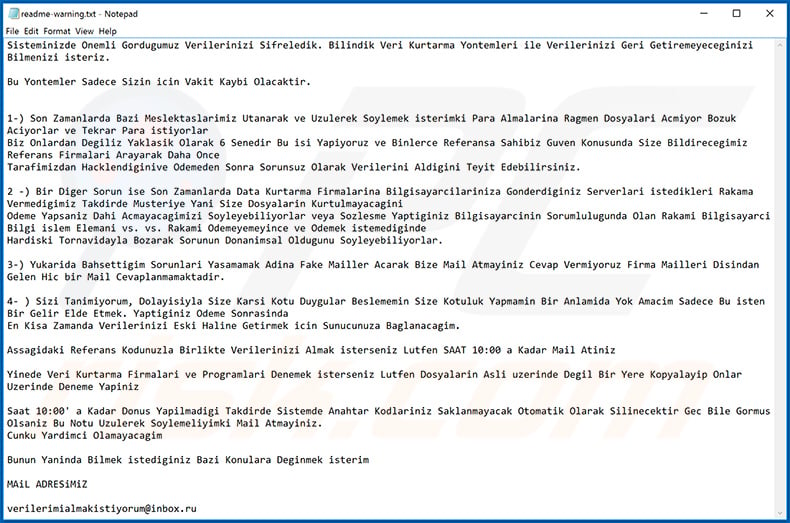
Text presented within this file:
Sisteminizde Onemli Gordugumuz Verilerinizi Sifreledik. Bilindik Veri Kurtarma Yontemleri ile Verilerinizi Geri Getiremeyeceginizi Bilmenizi isteriz.
Bu Yontemler Sadece Sizin icin Vakit Kaybi Olacaktir.
1-) Son Zamanlarda Bazi Meslektaslarimiz Utanarak ve Uzulerek Soylemek isterimki Para Almalarina Ragmen Dosyalari Acmiyor Bozuk Aciyorlar ve Tekrar Para istiyorlar
Biz Onlardan Degiliz Yaklasik Olarak 6 Senedir Bu isi Yapiyoruz ve Binlerce Referansa Sahibiz Guven Konusunda Size Bildirecegimiz Referans Firmalari Arayarak Daha Once
Tarafimizdan Hacklendiginive Odemeden Sonra Sorunsuz Olarak Verilerini Aldigini Teyit Edebilirsiniz.2 -) Bir Diger Sorun ise Son Zamanlarda Data Kurtarma Firmalarina Bilgisayarcilariniza Gonderdiginiz Serverlari istedikleri Rakama Vermedigimiz Takdirde Musteriye Yani Size Dosyalarin Kurtulmayacagini
Odeme Yapsaniz Dahi Acmayacagimizi Soyleyebiliyorlar veya Sozlesme Yaptiginiz Bilgisayarcinin Sorumlulugunda Olan Rakami Bilgisayarci Bilgi islem Elemani vs. vs. Rakami Odemeyemeyince ve Odemek istemediginde
Hardiski Tornavidayla Bozarak Sorunun Donanimsal Oldugunu Soyleyebiliyorlar.3-) Yukarida Bahsettigim Sorunlari Yasamamak Adina Fake Mailler Acarak Bize Mail Atmayiniz Cevap Vermiyoruz Firma Mailleri Disindan Gelen Hic bir Mail Cevaplanmamaktadir.
4- ) Sizi Tanimiyorum, Dolayisiyla Size Karsi Kotu Duygular Beslememin Size Kotuluk Yapmamin Bir Anlamida Yok Amacim Sadece Bu isten Bir Gelir Elde Etmek. Yaptiginiz Odeme Sonrasinda
En Kisa Zamanda Verilerinizi Eski Haline Getirmek icin Sunucunuza Baglanacagim.Assagidaki Referans Kodunuzla Birlikte Verilerinizi Almak isterseniz Lutfen SAAT 10:00 a Kadar Mail Atiniz
Yinede Veri Kurtarma Firmalari ve Programlari Denemek isterseniz Lutfen Dosyalarin Asli uzerinde Degil Bir Yere Kopyalayip Onlar Uzerinde Deneme Yapiniz
Saat 10:00' a Kadar Donus Yapilmadigi Takdirde Sistemde Anahtar Kodlariniz Saklanmayacak Otomatik Olarak Silinecektir Gec Bile Gormus Olsaniz Bu Notu Uzulerek Soylemeliyimki Mail Atmayiniz.
Cunku Yardimci OlamayacagimBunun Yaninda Bilmek istediginiz Bazi Konulara Deginmek isterim
MAiL ADRESiMiZ
verilerimialmakistiyorum@inbox.ru
Screenshot of files encrypted by this Makop ransomware variant:
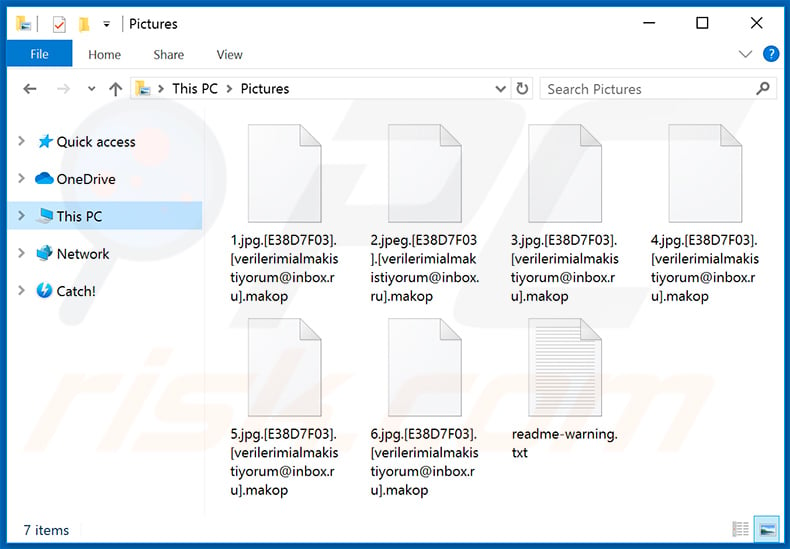
Update 7 July 2020 - Cyber criminals have recently released an updated variant of Makop ransomware. This version appends filenames with a random string, delivers a different ransom message, and the website is also updated.
Screenshot of this Makop ransomware variant text file:
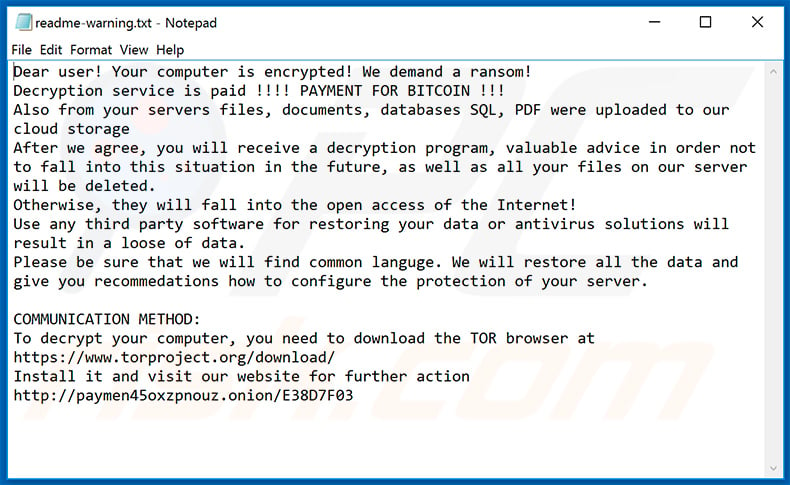
Text presented within:
Dear user! Your computer is encrypted! We demand a ransom!
Decryption service is paid !!!! PAYMENT FOR BITCOIN !!!
Also from your servers files, documents, databases SQL, PDF were uploaded to our cloud storage
After we agree, you will receive a decryption program, valuable advice in order not to fall into this situation in the future, as well as all your files on our server will be deleted.
Otherwise, they will fall into the open access of the Internet!
Use any third party software for restoring your data or antivirus solutions will result in a loose of data.
Please be sure that we will find common languge. We will restore all the data and give you recommedations how to configure the protection of your server.COMMUNICATION METHOD:
To decrypt your computer, you need to download the TOR browser at hxxps://www.torproject.org/download/
Install it and visit our website for further action hxxp://paymen45oxzpnouz.onion/E38D7F03
Screenshot of a website provided by this Makop ransomware variant:
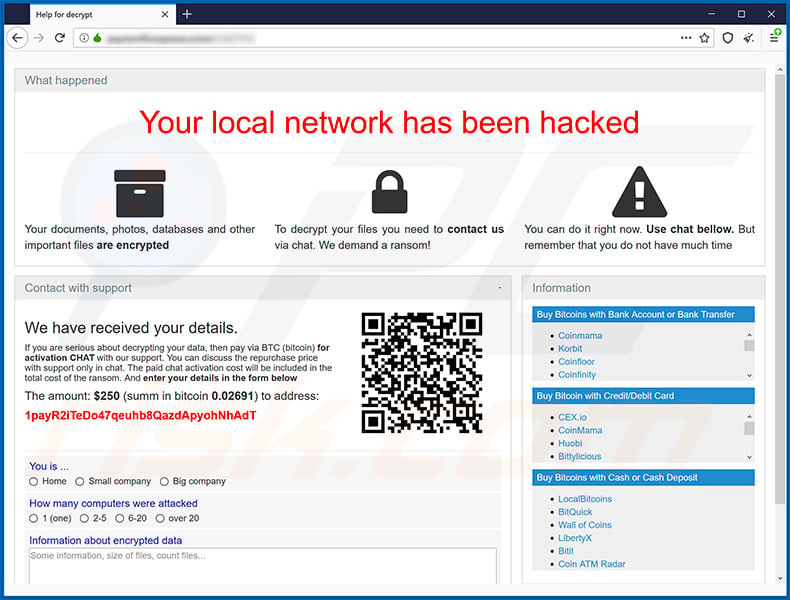
Text presented within:
What happened
Your local network has been hackedYour documents, photos, databases and other important files are encrypted
To decrypt your files you need to contact us via chat. We demand a ransom!
You can do it right now. Use chat bellow. But remember that you do not have much time
Contact with support
-
We have received your details.
If you are serious about decrypting your data, then pay via BTC (bitcoin) for activation CHAT with our support. You can discuss the repurchase price with support only in chat. The paid chat activation cost will be included in the total cost of the ransom. And enter your details in the form below
The amount: $250 (summ in bitcoin 0.02691) to address:
1payR2iTeDo47qeuhb8QazdApyohNhAdT
You is ...
Home Small company Big company
How many computers were attacked
1 (one) 2-5 6-20 over 20
Information about encrypted data
Information
Buy Bitcoins with Bank Account or Bank Transfer
Coinmama Korbit Coinfloor Coinfinity BitPanda BTCDirect Paymium Bity CoinCorner HappyCoins Coinbase
* Don't use Coinbase if you're in USA Bitfinex PoloniexBuy Bitcoin with Credit/Debit Card
CEX.io CoinMama Huobi Bittylicious BitPanda CoinCafe Coinhouse SafelloBuy Bitcoins with Cash or Cash Deposit
LocalBitcoins BitQuick Wall of Coins LibertyX Bitit Coin ATM Radar
Screenshot of files encrypted by this Makop ransomware variant (random extension):
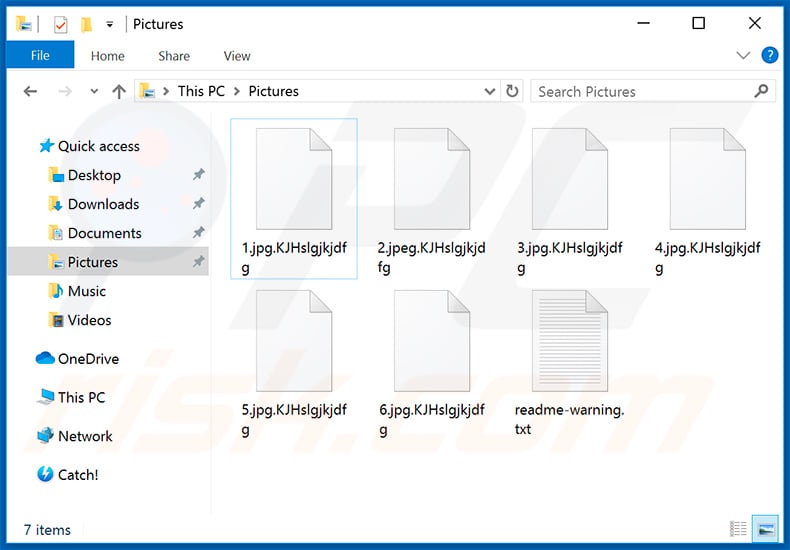
Appearance of a ransom note delivered by yet another Makop ransomware (GIF):
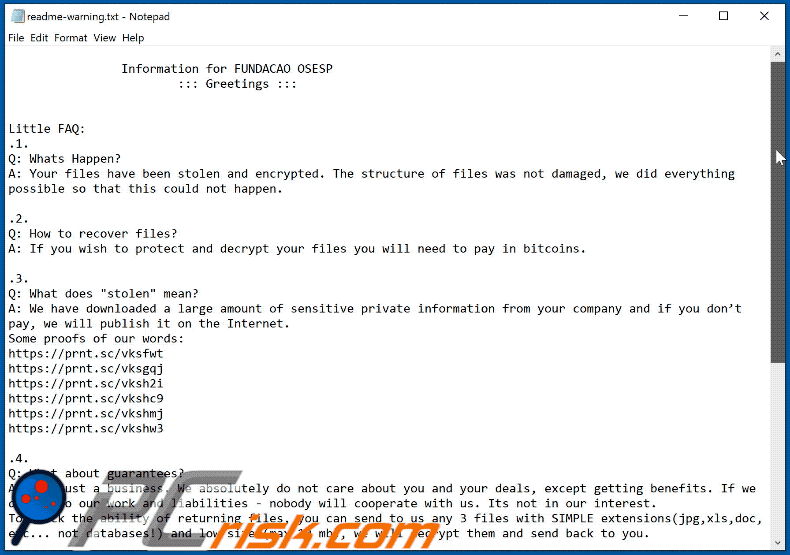
Text presented within:
Information for FUNDACAO OSESP
::: Greetings :::
Little FAQ:
.1.
Q: Whats Happen?
A: Your files have been stolen and encrypted. The structure of files was not damaged, we did everything possible so that this could not happen..2.
Q: How to recover files?
A: If you wish to protect and decrypt your files you will need to pay in bitcoins..3.
Q: What does "stolen" mean?
A: We have downloaded a large amount of sensitive private information from your company and if you don’t pay, we will publish it on the Internet.
Some proofs of our words:
hxxps://prnt.sc/vksfwt
hxxps://prnt.sc/vksgqj
hxxps://prnt.sc/vksh2i
hxxps://prnt.sc/vkshc9
hxxps://prnt.sc/vkshmj
hxxps://prnt.sc/vkshw3.4.
Q: What about guarantees?
A: Its just a business. We absolutely do not care about you and your deals, except getting benefits. If we do not do our work and liabilities - nobody will cooperate with us. Its not in our interest.
To check the ability of returning files, you can send to us any 3 files with SIMPLE extensions(jpg,xls,doc, etc... not databases!) and low sizes(max 10 mb), we will decrypt them and send back to you..5.
Q: How to contact with you?
A: You can write us to our mailbox: steaknshake@gmx.us or makop@keemail.me or makop.support@secmail.pro.6.
Q: How will the decryption process proceed after payment?
A: After payment we will send to you our scanner-decoder program and detailed instructions for use. This program will decrypt all your encrypted files.
:::BEWARE:::
DON'T try to change encrypted files by yourself!
If you will try to use any third party software for restoring your data or antivirus solutions - please make a backup for all encrypted files!
Any changes in encrypted files may entail damage of the private key and, as result, the loss all data.
Makop ransomware removal:
Instant automatic malware removal:
Manual threat removal might be a lengthy and complicated process that requires advanced IT skills. Combo Cleaner is a professional automatic malware removal tool that is recommended to get rid of malware. Download it by clicking the button below:
DOWNLOAD Combo CleanerBy downloading any software listed on this website you agree to our Privacy Policy and Terms of Use. To use full-featured product, you have to purchase a license for Combo Cleaner. 7 days free trial available. Combo Cleaner is owned and operated by RCS LT, the parent company of PCRisk.com.
Video suggesting what steps should be taken in case of a ransomware infection:
Quick menu:
- What is Makop virus?
- STEP 1. Reporting ransomware to authorities.
- STEP 2. Isolating the infected device.
- STEP 3. Identifying the ransomware infection.
- STEP 4. Searching for ransomware decryption tools.
- STEP 5. Restoring files with data recovery tools.
- STEP 6. Creating data backups.
If you are a victim of a ransomware attack we recommend reporting this incident to authorities. By providing information to law enforcement agencies you will help track cybercrime and potentially assist in the prosecution of the attackers. Here's a list of authorities where you should report a ransomware attack. For the complete list of local cybersecurity centers and information on why you should report ransomware attacks, read this article.
List of local authorities where ransomware attacks should be reported (choose one depending on your residence address):
USA - Internet Crime Complaint Centre IC3
United Kingdom - Action Fraud
Spain - Policía Nacional
France - Ministère de l'Intérieur
Germany - Polizei
Italy - Polizia di Stato
The Netherlands - Politie
Poland - Policja
Portugal - Polícia Judiciária
Isolating the infected device:
Some ransomware-type infections are designed to encrypt files within external storage devices, infect them, and even spread throughout the entire local network. For this reason, it is very important to isolate the infected device (computer) as soon as possible.
Step 1: Disconnect from the internet.
The easiest way to disconnect a computer from the internet is to unplug the Ethernet cable from the motherboard, however, some devices are connected via a wireless network and for some users (especially those who are not particularly tech-savvy), disconnecting cables may seem troublesome. Therefore, you can also disconnect the system manually via Control Panel:
Navigate to the "Control Panel", click the search bar in the upper-right corner of the screen, enter "Network and Sharing Center" and select search result: 
Click the "Change adapter settings" option in the upper-left corner of the window: 
Right-click on each connection point and select "Disable". Once disabled, the system will no longer be connected to the internet. To re-enable the connection points, simply right-click again and select "Enable". 
Step 2: Unplug all storage devices.
As mentioned above, ransomware might encrypt data and infiltrate all storage devices that are connected to the computer. For this reason, all external storage devices (flash drives, portable hard drives, etc.) should be disconnected immediately, however, we strongly advise you to eject each device before disconnecting to prevent data corruption:
Navigate to "My Computer", right-click on each connected device, and select "Eject": 
Step 3: Log-out of cloud storage accounts.
Some ransomware-type might be able to hijack software that handles data stored within "the Cloud". Therefore, the data could be corrupted/encrypted. For this reason, you should log-out of all cloud storage accounts within browsers and other related software. You should also consider temporarily uninstalling the cloud-management software until the infection is completely removed.
Identify the ransomware infection:
To properly handle an infection, one must first identify it. Some ransomware infections use ransom-demand messages as an introduction (see the WALDO ransomware text file below).

This, however, is rare. In most cases, ransomware infections deliver more direct messages simply stating that data is encrypted and that victims must pay some sort of ransom. Note that ransomware-type infections typically generate messages with different file names (for example, "_readme.txt", "READ-ME.txt", "DECRYPTION_INSTRUCTIONS.txt", "DECRYPT_FILES.html", etc.). Therefore, using the name of a ransom message may seem like a good way to identify the infection. The problem is that most of these names are generic and some infections use the same names, even though the delivered messages are different and the infections themselves are unrelated. Therefore, using the message filename alone can be ineffective and even lead to permanent data loss (for example, by attempting to decrypt data using tools designed for different ransomware infections, users are likely to end up permanently damaging files and decryption will no longer be possible even with the correct tool).
Another way to identify a ransomware infection is to check the file extension, which is appended to each encrypted file. Ransomware infections are often named by the extensions they append (see files encrypted by Qewe ransomware below).

This method is only effective, however, when the appended extension is unique - many ransomware infections append a generic extension (for example, ".encrypted", ".enc", ".crypted", ".locked", etc.). In these cases, identifying ransomware by its appended extension becomes impossible.
One of the easiest and quickest ways to identify a ransomware infection is to use the ID Ransomware website. This service supports most existing ransomware infections. Victims simply upload a ransom message and/or one encrypted file (we advise you to upload both if possible).

The ransomware will be identified within seconds and you will be provided with various details, such as the name of the malware family to which the infection belongs, whether it is decryptable, and so on.
Example 1 (Qewe [Stop/Djvu] ransomware):

Example 2 (.iso [Phobos] ransomware):

If your data happens to be encrypted by ransomware that is not supported by ID Ransomware, you can always try searching the internet by using certain keywords (for example, a ransom message title, file extension, provided contact emails, crypto wallet addresses, etc.).
Search for ransomware decryption tools:
Encryption algorithms used by most ransomware-type infections are extremely sophisticated and, if the encryption is performed properly, only the developer is capable of restoring data. This is because decryption requires a specific key, which is generated during the encryption. Restoring data without the key is impossible. In most cases, cybercriminals store keys on a remote server, rather than using the infected machine as a host. Dharma (CrySis), Phobos, and other families of high-end ransomware infections are virtually flawless, and thus restoring data encrypted without the developers' involvement is simply impossible. Despite this, there are dozens of ransomware-type infections that are poorly developed and contain a number of flaws (for example, the use of identical encryption/decryption keys for each victim, keys stored locally, etc.). Therefore, always check for available decryption tools for any ransomware that infiltrates your computer.
Finding the correct decryption tool on the internet can be very frustrating. For this reason, we recommend that you use the No More Ransom Project and this is where identifying the ransomware infection is useful. The No More Ransom Project website contains a "Decryption Tools" section with a search bar. Enter the name of the identified ransomware, and all available decryptors (if there are any) will be listed.

Restore files with data recovery tools:
Depending on the situation (quality of ransomware infection, type of encryption algorithm used, etc.), restoring data with certain third-party tools might be possible. Therefore, we advise you to use the Recuva tool developed by CCleaner. This tool supports over a thousand data types (graphics, video, audio, documents, etc.) and it is very intuitive (little knowledge is necessary to recover data). In addition, the recovery feature is completely free.
Step 1: Perform a scan.
Run the Recuva application and follow the wizard. You will be prompted with several windows allowing you to choose what file types to look for, which locations should be scanned, etc. All you need to do is select the options you're looking for and start the scan. We advise you to enable the "Deep Scan" before starting, otherwise, the application's scanning capabilities will be restricted.

Wait for Recuva to complete the scan. The scanning duration depends on the volume of files (both in quantity and size) that you are scanning (for example, several hundred gigabytes could take over an hour to scan). Therefore, be patient during the scanning process. We also advise against modifying or deleting existing files, since this might interfere with the scan. If you add additional data (for example, downloading files/content) while scanning, this will prolong the process:

Step 2: Recover data.
Once the process is complete, select the folders/files you wish to restore and simply click "Recover". Note that some free space on your storage drive is necessary to restore data:

Create data backups:
Proper file management and creating backups is essential for data security. Therefore, always be very careful and think ahead.
Partition management: We recommend that you store your data in multiple partitions and avoid storing important files within the partition that contains the entire operating system. If you fall into a situation whereby you cannot boot the system and are forced to format the disk on which the operating system is installed (in most cases, this is where malware infections hide), you will lose all data stored within that drive. This is the advantage of having multiple partitions: if you have the entire storage device assigned to a single partition, you will be forced to delete everything, however, creating multiple partitions and allocating the data properly allows you to prevent such problems. You can easily format a single partition without affecting the others - therefore, one will be cleaned and the others will remain untouched, and your data will be saved. Managing partitions is quite simple and you can find all the necessary information on Microsoft's documentation web page.
Data backups: One of the most reliable backup methods is to use an external storage device and keep it unplugged. Copy your data to an external hard drive, flash (thumb) drive, SSD, HDD, or any other storage device, unplug it and store it in a dry place away from the sun and extreme temperatures. This method is, however, quite inefficient, since data backups and updates need to be made regularly. You can also use a cloud service or remote server. Here, an internet connection is required and there is always the chance of a security breach, although it's a really rare occasion.
We recommend using Microsoft OneDrive for backing up your files. OneDrive lets you store your personal files and data in the cloud, sync files across computers and mobile devices, allowing you to access and edit your files from all of your Windows devices. OneDrive lets you save, share and preview files, access download history, move, delete, and rename files, as well as create new folders, and much more.
You can back up your most important folders and files on your PC (your Desktop, Documents, and Pictures folders). Some of OneDrive’s more notable features include file versioning, which keeps older versions of files for up to 30 days. OneDrive features a recycling bin in which all of your deleted files are stored for a limited time. Deleted files are not counted as part of the user’s allocation.
The service is built using HTML5 technologies and allows you to upload files up to 300 MB via drag and drop into the web browser or up to 10 GB via the OneDrive desktop application. With OneDrive, you can download entire folders as a single ZIP file with up to 10,000 files, although it can’t exceed 15 GB per single download.
OneDrive comes with 5 GB of free storage out of the box, with an additional 100 GB, 1 TB, and 6 TB storage options available for a subscription-based fee. You can get one of these storage plans by either purchasing additional storage separately or with Office 365 subscription.
Creating a data backup:
The backup process is the same for all file types and folders. Here’s how you can back up your files using Microsoft OneDrive
Step 1: Choose the files/folders you want to backup.

Click the OneDrive cloud icon to open the OneDrive menu. While in this menu, you can customize your file backup settings.

Click Help & Settings and then select Settings from the drop-down menu.

Go to the Backup tab and click Manage backup.

In this menu, you can choose to backup the Desktop and all of the files on it, and Documents and Pictures folders, again, with all of the files in them. Click Start backup.
Now, when you add a file or folder in the Desktop and Documents and Pictures folders, they will be automatically backed up on OneDrive.
To add folders and files, not in the locations shown above, you have to add them manually.

Open File Explorer and navigate to the location of the folder/file you want to backup. Select the item, right-click it, and click Copy.

Then, navigate to OneDrive, right-click anywhere in the window and click Paste. Alternatively, you can just drag and drop a file into OneDrive. OneDrive will automatically create a backup of the folder/file.

All of the files added to the OneDrive folder are backed up in the cloud automatically. The green circle with the checkmark in it indicates that the file is available both locally and on OneDrive and that the file version is the same on both. The blue cloud icon indicates that the file has not been synced and is available only on OneDrive. The sync icon indicates that the file is currently syncing.

To access files only located on OneDrive online, go to the Help & Settings drop-down menu and select View online.

Step 2: Restore corrupted files.
OneDrive makes sure that the files stay in sync, so the version of the file on the computer is the same version on the cloud. However, if ransomware has encrypted your files, you can take advantage of OneDrive’s Version history feature that will allow you to restore the file versions prior to encryption.
Microsoft 365 has a ransomware detection feature that notifies you when your OneDrive files have been attacked and guide you through the process of restoring your files. It must be noted, however, that if you don’t have a paid Microsoft 365 subscription, you only get one detection and file recovery for free.
If your OneDrive files get deleted, corrupted, or infected by malware, you can restore your entire OneDrive to a previous state. Here’s how you can restore your entire OneDrive:

1. If you're signed in with a personal account, click the Settings cog at the top of the page. Then, click Options and select Restore your OneDrive.
If you're signed in with a work or school account, click the Settings cog at the top of the page. Then, click Restore your OneDrive.
2. On the Restore your OneDrive page, select a date from the drop-down list. Note that if you're restoring your files after automatic ransomware detection, a restore date will be selected for you.
3. After configuring all of the file restoration options, click Restore to undo all the activities you selected.
The best way to avoid damage from ransomware infections is to maintain regular up-to-date backups.
Frequently Asked Questions (FAQ)
How was my computer hacked and how did hackers encrypt my files?
Cybercriminals distribute ransomware in several ways. They attempt to trick users into executing malware by themselves. Usually, users cause computer infections via malicious emails, software cracking tools, files downloaded from unreliable sources, drive-by downloads, fake installers.
How to open ".makop" files?
Once Makop has encrypted files, they cannot be opened. Decryption is required for file usage.
Where should I look for free decryption tools for Makop ransomware?
In case of a ransomware attack you should check the No More Ransom project website (more information above).
I can pay you a lot of money, can you decrypt files for me?
We do not provide a file decryption service. Third parties offering decryption should not be paid. Typically, they act as man-in-the-middle or do not provide a decryption tool even after the payment. In most cases, files encrypted by ransomware cannot be decrypted without the interference of cybercriminals unless the ransomware has certain vulnerabilities.
Will Combo Cleaner help me remove Makop ransomware?
Yes, Combo Cleaner will scan the operating system and remove ransomware. It is important to remove ransomware to prevent further data loss/computer infections. It is worth mentioning that files remain encrypted even when ransomware is no longer active/present.
Share:

Tomas Meskauskas
Expert security researcher, professional malware analyst
I am passionate about computer security and technology. I have an experience of over 10 years working in various companies related to computer technical issue solving and Internet security. I have been working as an author and editor for pcrisk.com since 2010. Follow me on Twitter and LinkedIn to stay informed about the latest online security threats.
PCrisk security portal is brought by a company RCS LT.
Joined forces of security researchers help educate computer users about the latest online security threats. More information about the company RCS LT.
Our malware removal guides are free. However, if you want to support us you can send us a donation.
DonatePCrisk security portal is brought by a company RCS LT.
Joined forces of security researchers help educate computer users about the latest online security threats. More information about the company RCS LT.
Our malware removal guides are free. However, if you want to support us you can send us a donation.
Donate
▼ Show Discussion